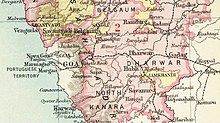Jamkhandi State
| Jamkhandi State ಜಮಖಂಡಿ ಸಂಸ್ಥಾನ | |||||||||
|---|---|---|---|---|---|---|---|---|---|
| State Within the Maratha Confederacy (1811 - 1818) Princely State of British India | |||||||||
| 1811–1948 | |||||||||
 Jamkhandi State in the Imperial Gazetteer of India | |||||||||
| Area | |||||||||
• 1901 | 1,357 km2 (524 sq mi) | ||||||||
| Population | |||||||||
• 1901 | 105,357 | ||||||||
| History | |||||||||
• Established | 1811 | ||||||||
• Acceded to the Union of India | 1948 | ||||||||
| |||||||||
| Today part of | Karnataka, India | ||||||||
Jamkhandi State was one of the Maratha princely states of British India.[1] It was founded in 1811 and its capital was at Jamakhandi.[2] It was administered as part of the Deccan States Agency of the Bombay Presidency and was one of the former states of the Southern Maratha Country. The area that was under this princely state is part of present day Karnataka.
History
[edit]Jamkhandi state was founded in 1811 by Shrimant Gopalrao Patwardhan. He was a descendant of Bramhibhoot Harbhat Buva Patwardhan of Kurandvad Senior State.
The name of the state was derived from Jambukeshwar temple. The temple itself got the name because it was deep inside a Jambul blueberry (Jambul in Marathi, Nerale Hannu in Kannada, Jamun in Hindi) forest. Today, a primary school functions from the temple precinct.[3]
The town of Kundgol, which is in the neighboring Dharwar district, was a non-contiguous part of Jamkhandi State until it merged into the Indian Union on 19t February 1948.
Rulers
[edit]The rulers of the state bore the title 'Raja'. The Rajas of Jamkhandi belonged to the Patwardhan dynasty.[4]
The rulers of Jamkhandi were of the Chitpavan Brahmin caste, originally from the Kotawada in Ratnagiri. Haribhat, who was the family priest of another Chitpavan Brahmin, the chief of Ichalkaranji. Three of Haribhat's sons served Peshwa and distinguished themselves during various conquests. The Peshwa awarded them Jagirs of Jamkhandi, Miraj, Sangli and Kurundvad, to honor their bravery and courage.

Jamkhandi was one of the Maratha Princely States of British India and was administered as part of the Bombay Presidency, later by the Deccan States Agency. Jamkhandi was founded by Gopalrao Ramchandrarao Patwardhan (1799–1840) in 1811. He was succeeded by Ramchandrarao Gopalrao Patwardhan (1833–1897), who was a very capable administrator, and moved his capital to Ramtirth, a hill near Jamkhandi, next to an old temple.[5]
Rajas
[edit]| Period | Name | Relevance |
|---|---|---|
| 1811 - 1840 | Gopalrao Ramchandrarao Patwardhi | Established the princely state |
| 1840 - 1897 | Ramchandrarao Gopalrao Patwardhan (Appa Sahib Patwardhan) | Moved capital to Ramtirth and built the palace. |
| 1897 - 1924 | Parshuramrao a.k.a. Bhausaheb Patwardhan | Adopted rajah, took part in Indian Army during World War I.
British Empire honored him with Order of the Indian Empire |
| 1924 - 1947 | Shankar Rao Parashuram Rao a.k.a. Appa Sahib Patwardhan (b. 1906) | Killed by an elephant. First raja to show willingness to join India.[6] |
| 1947 - signing of Charter of Merger | Parshuramrao Ramchandrarao Patwardhan II | Last rajah who completed Political integration to India |
Jamakhandi was the first princely state which shown willingness to join Dominion of India the accession was based on three conditions viz. Jamakhandi should be a district (it was made part of Bagalkot district instead), construction of Bagalkote - Kudachi railway line (the project is expected to complete by 2025) and Barrage cum bridge across Krishna River at Jambagi (wasn't completed as of 2014).[6][7]
Famous people
[edit]See also
[edit]References
[edit]- ^ Imperial Gazetteer of India, v. 14, p. 46.
- ^ Jamkhandi (Princely State)
- ^ Swami Vivekanand English Medium school and Nutan Vidyalaya Kannada Gandu Makkala Shale, ನೂತನ ವಿದ್ಯಾಲಯ ಕನ್ನಡ ಗಂಡು ಮಕ್ಕಳ ಶಾಲೆ
- ^ Princely States of India
- ^ Jadeja, Arjunsinh (22 October 2013). "The migrant rulers of Jamkhandi". No. Bangalore. Deccan Herald. Retrieved 2 February 2015.
- ^ a b "Jamkhandi isn't tired of democracy's jostle". The Times of India. 4 April 2014. ISSN 0971-8257. Retrieved 25 November 2023.
- ^ Bureau, The Hindu (6 September 2023). "Bagalkot-Kudachi railway line to be completed by the end of 2025". The Hindu. ISSN 0971-751X. Retrieved 25 November 2023.
External links
[edit]- . Encyclopædia Britannica. Vol. 15 (11th ed.). 1911. p. 149.
- Jamkhandi State जमखंडी संस्थान


